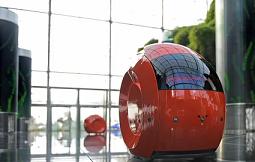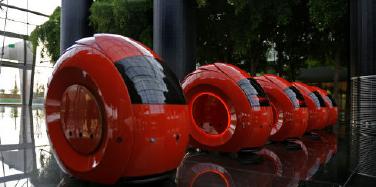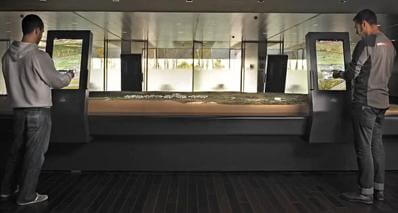
Amazing! Someone took all the stunning technological advancements of the past decade and actually made a building that looks like it belongs in the 21st Century. “El Faro”, the lighthouse, is an interactive visitors center that features robots, augmented reality stations, huge tactile interface walls, and flowing LED lights. It’s like something out of Minority Report or Blade Runner. Set on the massive 16 hectare compound of Santander Bank outside of Madrid, El Faro awes its guests with technology that transforms their surroundings into a interactive mesh of the physical and digital worlds. I can’t adequately describe how awesome this place looks, so check out the video below instead. Integrated technologies providing humans with an enhanced environment – welcome to the future, boys and girls.
Santander is one of the largest banks on the planet: third in profits, seventh in stock market capital. They hired Portuguese company YDreams to create a unique entry point to their new compound outside of Madrid. Something to awe visitors and demonstrate Santander’s prestige. Mission accomplished. El Faro opens with a 30 meter glass cube surrounding an expansive walkway with trees covered in spiraling LED lights. Guests are greeted by robot guides to take them to their destination. I’m impressed and I haven’t even been there yet:
There are four major technologies at work in El Faro. The simplest is the LED light show that covers the space, giving visitors up to minute stock prices, as well as providing a shifting array of color. The second piece of tech is a large (12m) interactive wall where users can guide the visuals they see through touch. It’s not the biggest touchscreen we’ve seen, or even the most fun, but it looks great and really fits in with the surroundings as a whole.

The third technology is autonomous robot guides. The Santander Interactive Guest Assistants (SIGA, “follow” in Spanish) are designed to escort visitors. When you arrive at El Faro, a totem stand allows you to select your language and destination. A SIGA robot will then approach you and lead you while providing ambient music. The bots use RF tags, gyroscopes, and odometers to determine their position and 16 sonar sensors let them locate objects (such as the human they are guiding) while they move. They can run for 6 hours on their battery and know when and how to recharge themselves when drained. Except for input at the totem station, SIGA bots work completely autonomously. All that and they look like the light cycles from Tron. Slick.
Finally, El Faro features a great use of augmented reality. A large 3D model of the 16 hectare Santander complex is displayed on a table. Four moving touchscreens slide along the table providing enhanced views of the compound. Lasers help each screen know their position and exactly what a user wants to see. Look through a screen and you get a view of much more than the buildings in the model, you can explore related information, videos, and architectural features. It’s a great use of AR to merge real and virtual objects and data.

YDreams has only been around for ten years, but I think their work at El Faro demonstrates their expertise. It’s not that any one of these technologies is years ahead of the competition, in fact we’ve seen all of them before. The true genius lies in integrating all of these cutting edge multimedia experiences into one space and with one uniting vision. This is what 21st century design should look like. The space is dynamic, it’s interactive, and it’s useful. El Faro is an example of what every office building lobby could look like in the years ahead. Eventually, this sort of tech could be integrated into all of our homes as well. As each of these individual techs (AR, robotics, human computer interfaces) develop, the possibilities will get better and better. Maybe I shouldn’t call El Faro a “21st Century building”…maybe I should call it a “2010 building.” In another decade we’ll have the means to make this space look positively archaic. We’re moving towards a world where the physical and digital will merge into one environment. This is a great step in that direction. The next one is sure to be even more mind-blowing.
[image and video credits: YDreams]
[source: YDreams, Santander]



